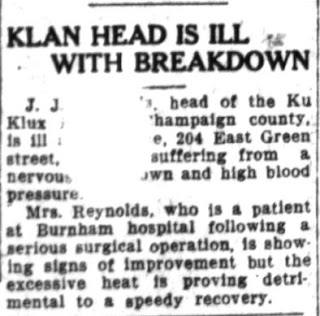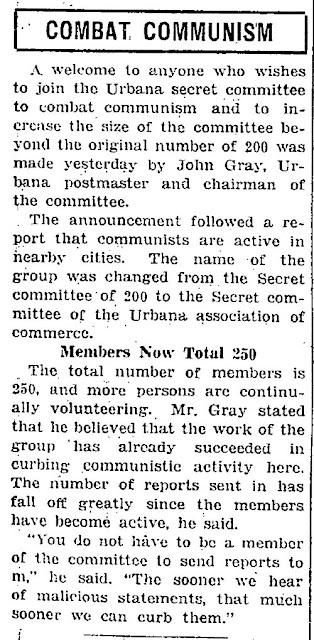 |
| Smoldering Remains of Urbana's Klan Headquarters - 4/4/1927 News-Gazette |
In 1926, news of corruption, scandal, and the Klan continued to pour out of Indiana even after its Grand Dragon was in prison. We've laid out just how prolific the Klan was in politics and corruption here in Illinois, just by examining one county and its connections to the larger movement. Indiana was worse. The negative headlines and hypocrisy didn't just flow across our neighboring border. They were national news and the Klan would begin to visibly decline here and across the country.
The local Klan's decline over 1926-1927 would be exemplified by the destruction of its local headquarters on 4/3/1927. The building was notorious for its giant electric "fiery cross" on the roof next to downtown Urbana and electrically lit "monster K's" at events. It would burn to the ground and blamed on an electrical fire.
The ironic ending was made all the more so since the Urbana Klan headquarters and its electric "fiery cross" were bragged about in Klan papers across the country. Example from the Oklahoma Herald on 11/13/1923:
1926 started off with the usual local Klan problem of "unauthorized" Klan cross burnings, with the official Klan leadership "helping" authorities catch the troublemakers. From the 1/8 and 1/13/1926 Champaign News-Gazette:
The "Exalted Cyclops" would remain the Klan's most public figure. On 3/10/1926 the News-Gazette noted his big Klan birthday party details:
In July the Illinois State "Klorero" meeting of Klan leaders took place in Clinton, IL. It was hosted by the Dewitt Clinton Klan No. 118, just down the interurban rail lines a couple counties west of the Twin Cities. While many Champaign Klansmen likely attended the event, the local "Exalted Cyclops" himself was reported to have been suffering from a "nervous breakdown" at the time. From the 7/2 and 7/4/1926 News-Gazette as well as the 7/6/1926 Bloomington Pantagraph.
The Illinois Traction System linked most of the cities, towns and villages in the area at a time when hard roads were scarce and car travel could be easily hindered by Illinois weather. As of this writing the Champaign County History Museum still has an exhibit on the Traction System. Illinois Traction offered and advertised half-rates to nearby Klan members to attend the Clinton event, including here in Champaign. From the 7/1/1926 Daily Illini and Clinton Daily Public:
The coverage of the leadership meeting in Clinton described a massive event with a great deal of Illinois Klan leadership. The 7/7/1926 Clinton Morning Journal had an overview of event afterwards, bragging about record attendance and the participation of the new Grand Dragon of Illinois Gail S. Carter.
The Clinton coverage from the day of the event included the written remarks of the Imperial Wizard, who was unable to drive through Illinois muddy roads to get there either. Click to enlarge the front page (and continued article with highlights) or Evans' remarks in the same 7/4/1926 edition of the Morning Journal:
August saw more cross burnings in Champaign County. One cross burning targeted the Black coroner who handled some of the duties specific to the Black community in the segregated system of 1926. The Northern implementation of "separate but equal" and enforcement of the color line often meant that white officials would designate some duties to Black community members. This would occur for issues that white officials in control of the offices deemed within the realm of the black community or, as they often put it, "their race." From the 8/11/1926 News-Gazette:
The cross burnings were related to the investigation of the "Triangular Deaths" mystery during the very violent July and August of 1926 in the Twin Cities. The interracial murders, scandal, and suicides were interlinked with segregated true-crime style drama, rumors, and intrigue. The 8/15/1926 had an overview of the Triangular Deaths story, players, and a listing of the violent deaths (click to enlarge):
The News-Gazette would criticize the use of cross burning as a form of intimidation in an editorial on 8/12/1926. The openly pro-Klan Sheriff John Gray would deny the Klan's involvement, saying that "the Klan has too much sense to do such a thing."
Area Klan Events:
Large events in nearby counties attracted Klan members from nearby towns, but with fewer details in the local newspaper coverage, it can be difficult to determine how large any delegation from the Twin Cities may have been. Area newspapers printed various town and village personal news of social events, visitors, travels (the 1920s equivalent of social media). But mentions of the attending or traveling to Klan events quickly evaporated with the increased scandals and souring reputation.
Here's an example from the Mattoon Klan where Klan Reverend J. F. McMahan was still active. Event details from the Mattoon Journal-Gazette on 8/14 and 8/16/1926:
Another large Klan event in Decatur was held as part of the city's labor day festivities. It specifically noted a large Champaign delegation attending. The 9/6 and 9/7/1926 Decatur Herald & Review listed the Klan picnic details among the other Labor Day events and had coverage of the Klan event afterward.
There were also smaller events nearby over the summer that may have had visitors from the Champaign County area, but it's less likely. Bloomington had a couple examples advertised and covered in the Bloomington Pantagraph. The advertisements and coverage highlight "Klan Field" which was located near a Maplewood Country Club, a "roaring 20s hot spot." From the 6/29, 7/30, and 8/2/1926 Bloomington Pantagraph:
The 2nd annual Klan parade in Washington D.C. was smaller than the one in 1925, but it still made news headlines and articles across the nation. An example from the Decatur Herald & Review had pictures in its set of national news items, but also pointed out the disappointing turnout in its 9/17/1926 edition:
At least some of the Champaign County Klan were part of the Washington D.C. events. The daughter of the local "Exalted Cyclops," Mary Reynolds, made the local and Washington papers. From the 9/14/1926 News-Gazette:
I wasn't able to find the Mary Reynolds pictures in the Washington papers yet. The Library of Congress has other parade photos from the Washington D.C. Evening Star here and here. They also had several in their photo collections here, including this bird's eye view:
The 4th annual Klan Christmas event for local kids was mentioned in the 12/15/1926 News-Gazette and covered in the 12/24/1926 Twin City Review:
Once again the papers don't spoil the mystery of who is playing the role of Santa Clause.
Early in 1927 there was a two day Illinois Klan "Klorero" leadership meeting at the Illinois Theater. The Courier announced the details on 2/10/1927 which included the various auxiliaries of the Klan: the Tri-K Klub for teenage girls, the Junior Klan for boys, and the W.K.K.K. women's Klan auxiliary. The News-Gazette had partial coverage on 2/13/1927:
Less than two months later the local Klan headquarters would burn to the ground. The last meeting there involved a play for the local Parent Teacher Association. The initial news articles included various rumors on the possible cause. Headlines from the 4/3 and 4/4/1927 News-Gazette (click to enlarge):
The Daily Illini Articles on 4/3, 4/5, and 4/6/1927 have a pretty concise overview of the news. The building burnt down, the latest insurance coverage didn't cover the full value of the building, and it notes Reynolds and his Zenith Amusement Company are the owners:
The Courier's coverage on 4/4/1927 also highlighted "Exalted Cyclops" J. J. Reynold's belief that the fir was electrical in cause. Explosions and other concerns explained by gas and fireworks stored on the site. It also confirmed plans to move Klan offices to the Burres building, with meetings to be held in Webber Hall next door.
The Twin City Review coverage on 4/8/1927 also blamed "faulty wiring" and similarly explained the explosions witnessed during the fire:
In the next post we'll see Klan activity further dwindle and also become more difficult to track through news coverage. We'll also see a lot of denials of Klan affiliation and more forceful denunciations of the Klan in hindsight by local papers. In a couple years the Klan will even deny that their local Klan headquarters with the electric fiery cross on the roof was owned by the Klan.
Local Klan members will still be found in positions of authority, political and legal power as the fraternal organization stagnates, however. They'll continue to mingle among the prominent members of other fraternal organizations, business groups, and political circles fully aware of their Klan history.












































No comments:
Post a Comment